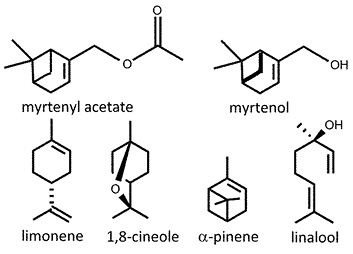 Myrtus communis
Myrtus communis
myrtle
Back to “Culinary herbs: myrtle (Myrtus communis)*”
Back to “Spices: myrtle (Myrtus communis)fr”
Myrtus communis L. (Myrtaceae); mirt (Afrikaans); xiang tao mu (Chinese); myrte (French); Echte Myrte (German); mirto (Italian); maatoru (Japanese); mirto (Portuguese); mirto (Spanish); myrten (Swedish)
DESCRIPTION The leaves are dark glossy green, with a sweet aroma and a bitter taste. The edible berries are dark purple to black when ripe. They resemble small guavas (note the persistent calyx) and have a sweet but somewhat resinous taste.
THE PLANT The true myrtle is an attractive evergreen shrub of 2–3 m (ca. 6–10 ft) high, with small white flowers bearing numerous stamens. The original (wild) form of the species has relatively large, dark green leaves (as shown here) but ornamental cultivars may have very small or variegated leaves.
ORIGIN The plant has been cultivated since ancient times, so that its exact origin is not known.1 Plants are now found from the Mediterranean area to southern Asia. Myrtle is associated with Roman and Greek mythology, rituals and ceremonies.1
CULTIVATION Plants are easily propagated from cuttings. They adapt to almost any climate and are remarkably resistant to frost. Commercial cultivation is mainly aimed at the distillation of essential oil from the leaves (eau d’Ange), which is used in perfumery.1 Myrtle is often grown as a focal point in the herb garden and makes an attractive clipped hedge.
HARVESTING Fresh leaves and ripe berries are hand-picked when required. The berries can be dried and stored for future use as spice.
CULINARY USES The Romans used myrtle leaves to flavour stews and wines and the plant is still locally important in the cuisines of Corsica and Sardinia. 2 On these islands they are added to bouillabaisse and dishes of pork and wild boar.2 Myrtle fruits or leaf extracts are used to make a liqueur known as mirto.2 Leaves and berries can be used in stuffings, or a roast or game bird wrapped in leaves for five to ten minutes before serving. Dried berries can be ground in a pepper mill to add a spicy flavour to stews and meat dishes. Leafy twigs or dried leaves can be added to the fire while roasting meat. The essential oil is used to flavour meat sauces and seasonings.3
FLAVOUR COMPOUNDS The aroma and flavour is due to the presence of essential oil (myrtle oil)3 rich in limonene, 1,8-cineole, α-pinene and linalool.4 Myrtenyl acetate and myrtenol occur only in some chemotypes.5

NOTES Since ancient times, myrtle has been regarded as sacred to Venus and as a symbol of beauty, love and purity. Kate Middleton, Diana Spencer and Queen Elizabeth all followed royal tradition by having myrtle in their bridal bouquets. The tradition was started by Princess Victoria in 1858 when she married the future Frederick III of Germany. A sprig was taken from the famous myrtle planted by her mother, Queen Victoria, at Osborne House on the Isle of Wight.
1. Mabberley, D.J. 2008. Mabberley’s plant-book (3rd ed.). Cambridge University Press, Cambridge.
2. Larousse. 1999. The concise Larousse gastronomique. Hamlyn, London.
3. Harborne, J.B., Baxter, H. 2001. Chemical dictionary of economic plants. Wiley, New York.
4. Tuberoso, C.I., Barra, A., Angioni, A., Sarritzu, E., Pirisi, F.M. 2006. Chemical composition of volatiles in Sardinian myrtle (Myrtus communis L.) alcoholic extracts and essential oils. Journal of Agricultural and Food Chemistry 54: 1420–1426.
5. Pereira, P.C., Cebola, M.-J., Bernardo-Gil, M.G. 2009. Evolution of the yields and composition of essential oil from Portuguese myrtle (Myrtus communis L.) through the vegetative cycle. Molecules 14: 3094–3105.